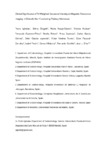Mostrar o rexistro simple do ítem
Clinical significance of T2-weighted sequence intensity on magnetic resonance imaging in clinically non-functioning pituitary adenomas
| dc.contributor.author | Iglesias, Pedro | |
| dc.contributor.author | Biagetti, Betina | |
| dc.contributor.author | Araújo-Castro, Marta | |
| dc.contributor.author | Alcázar, Victoria | |
| dc.contributor.author | Guerrero-Pérez, Fernando | |
| dc.contributor.author | Riveiro, Noelia | |
| dc.contributor.author | Casteràs, Anna | |
| dc.contributor.author | García Gómez, Carlos | |
| dc.contributor.author | García Izquierdo, Belén | |
| dc.contributor.author | Viedma Torres, Víctor | |
| dc.contributor.author | Pascual-Corrales, Eider | |
| dc.contributor.author | Pavón, Isabel | |
| dc.contributor.author | Villabona, Carles | |
| dc.contributor.author | Cordido, Fernando | |
| dc.contributor.author | Díez, Juan J. | |
| dc.date.accessioned | 2024-01-19T08:34:23Z | |
| dc.date.issued | 2023-12 | |
| dc.identifier.citation | Iglesias P, Biagetti B, Araujo-Castro M, Alcázar V, Guerrero-Pérez F, Rivero N, Casteràs A, García Gómez C, García Izquierdo B, Viedma Torres V, Pascual-Corrales E, Pavón I, Villabona C, Cordido F, Díez JJ. Clinical significance of T2-weighted sequence intensity on magnetic resonance imaging in clinically non-functioning pituitary adenomas. Exp Clin Endocrinol Diabetes. 2023 Dec;131(12):631-638. | es_ES |
| dc.identifier.issn | 0947-7349 | |
| dc.identifier.uri | http://hdl.handle.net/2183/35000 | |
| dc.description | Multicenter study | es_ES |
| dc.description.abstract | [Abstract] Background Little is known about the relationship between signal intensity patterns on T2-weighted magnetic resonance imaging (MRI) in non-functioning pituitary adenomas (NFPAs). Objective In this study, the clinical, hormonal, histological features, and therapeutic responses were evaluated according to the T2 signal intensity in NFPAs. Methods This retrospective and multicenter study included a group of 166 NFPA patients (93 men, 56%, mean age 58.5 ±14.8 yr). Results: Approximately half of the tumors (n=84, 50.6%) were hyperintense, while 34.3% (n=57) and 15.1% (n=25) were iso- and hypointense, respectively. The median maximum tumor diameter of the isointense group [16 (13–25) mm] was significantly lower than that of the hyperintense [23 (16.6–29.7) mm] group (p=0.003). Similarly, the tumor volume of the isointense group [1,523 (618–5,226) mm3] was significantly lower than that of the hyperintense [4,012 (2,506–8,320) mm3] group (p=0.002). Chiasmatic compression occurred less frequently in tumors with isointense signal characteristics (38.6%) compared to tumors with hypointense (68%) and hyperintense (65.5%) signal characteristics (p=0.003). Invasive adenomas (p=0.001) and the degree of cavernous sinus invasion (p<0.001) were more frequent in the hyperintense adenoma group compared to the remaining groups. Plurihormonal tumors and silent lactotroph adenomas were more frequent in the isointense tumor group. Conclusion In conclusion, hyperintensity on T2-weighted MRI in NFPAs is associated with larger and more invasive tumors compared to isointense NFPAs. | es_ES |
| dc.language.iso | eng | es_ES |
| dc.publisher | Thieme | es_ES |
| dc.relation.uri | https://doi.org/10.1055/a-2197-3566 | es_ES |
| dc.rights | © Thieme | es_ES |
| dc.subject | Nonfunctioning pituitary adenoma | es_ES |
| dc.subject | T2-weighted magnetic resonance imaging | es_ES |
| dc.subject | Clinical outcome | es_ES |
| dc.title | Clinical significance of T2-weighted sequence intensity on magnetic resonance imaging in clinically non-functioning pituitary adenomas | es_ES |
| dc.type | info:eu-repo/semantics/article | es_ES |
| dc.rights.access | info:eu-repo/semantics/embargoedAccess | es_ES |
| dc.date.embargoEndDate | 2025/12/01 | es_ES |
| dc.date.embargoLift | 2025 | |
| UDC.journalTitle | Experimental and Clinical Endocrinology & Diabetes | es_ES |
| UDC.volume | 131 | es_ES |
| UDC.issue | 12 | es_ES |
| UDC.startPage | 631 | es_ES |
| UDC.endPage | 638 | es_ES |






